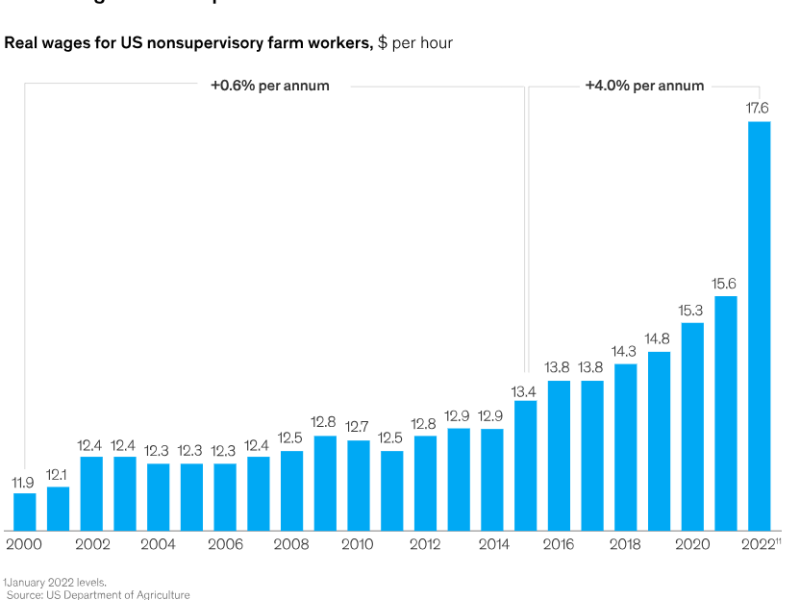Australia, well known for its robust agricultural sector, faces new challenges that call into question our long-standing perception as a food secure nation. The recent report from The House of Reps Standing Committee on Agriculture, titled “Australian Food Story: Feeding the Nation and Beyond,” sheds light on these challenges and emphasizes the need for a comprehensive strategy to strengthen and safeguard Australia’s food security.
Historically, Australia has consistently held a very high rating for food security internationally, along with Canada, Germany, and France. However, this recent report is calling our longstanding security into question, which was expected to recover post COVID. However, what we saw before 2020, may not continue to hold true without clear leadership and strategy to deal with emerging issues in the Aussie agricultural sector.

Agriculture is tied to the cost of living, so our consumer price index becomes a useful metric to consider when looking at food security risk. Take a look at the graph above. This plots the rise in food and drink costs affecting everyday Australians in a sample urban area, Brisbane Qld. In 2022 Brisbanians were no longer spending what was required to meet their recommended diet. This could well reflect that expenses for the recommended diet rose 18% in three years, with the habitual diet cost rising only 12% in the same time period. The Consumer Price Index for All Urban Consumers increased 3% from July 2022 to July 2023. More specifically, food prices cross nationally increased 5% percent from July 2022 to July 2023. So, what happened?
Identified Challenges to Food Security The outbreak of COVID-19 exposed vulnerabilities in the nation’s food supply chain, with empty supermarket shelves becoming a stark reality. Lockdowns and border closures led to labour shortages, and disruptions in international trade resulted in periodic shortages of key inputs, such as the infamous AdBlue shortage.
Global events, including the conflict in Ukraine, have triggered shortages of essential grains, contributing to rising global food prices. Additionally, fuel and energy price hikes have resulted in sustained food price inflation, impacting consumers and farmers alike.
Biosecurity risks, highlighted by the outbreak of Foot and Mouth Disease and Lumpy Skin Disease in Indonesia, underscore the vulnerability of Australia’s food-producing industries. The recent arrival of the Varroa mite on Australian shores further emphasizes the tangible nature of these risks. Climate change poses additional challenges to food production and security, while the broader issue of food insecurity within the Australian population looms large.
Technology: Bridging Gaps in Food Security With regards to ag-tech, a few recommendations stand out. The Committee recommended that the Australian Government, as part of the National Food Plan, expand innovation / value adding practices in food production, with a view to enhancing commercial opportunities for Australian industry and enhancing food security. The Committee also recommended that the Australian Government, as part of the National Food Plan, develop mechanisms to promote innovation in food production.
In response to these recommendations, Agricultural Robotics can play a pivotal role in bolstering Australia’s food security. Our advanced robotics and automation precision farming technologies aim to address key areas identified in the report, including:
- Food Production, Consumption, and Trade Enhancing efficiency and productivity in agricultural practices.
- Access to Key Production Inputs Ensuring a stable supply chain of essential resources to minimize production costs.
- Food Supply Chain Resilience Implementing technologies to manage and minimize food waste along the supply chain.
- Climate Change and Biosecurity Developing solutions to mitigate the impact of climate change on agriculture and enhance biosecurity measures.
- Addressing Food Insecurity Implementing innovative approaches to improve access to nutritious food for all Australians.
Policy and the People The last National Food Plan is dated 2013. A lot has certainly happened in the decade since its publication for primary producers and agribusiness. A refresh of this document appears due, given the noted emerging challenges as well as new agritech solutions.
As Australian farmers, fishers, and local communities organise to successfully confront the multifaceted challenges outlined in this report, the role of advanced technologies, such as those developed by Agricultural Robotics, become increasingly vital. By aligning with the goals outlined in the report and fostering innovation, we strive to contribute to the development of a comprehensive national food security strategy. Together, we can ensure that all Australians have access to sufficient, safe, and nutritious food, securing the nation’s food future and beyond.
© Commonwealth of Australia 2023
ISBN: 978-1-76092-587-1



